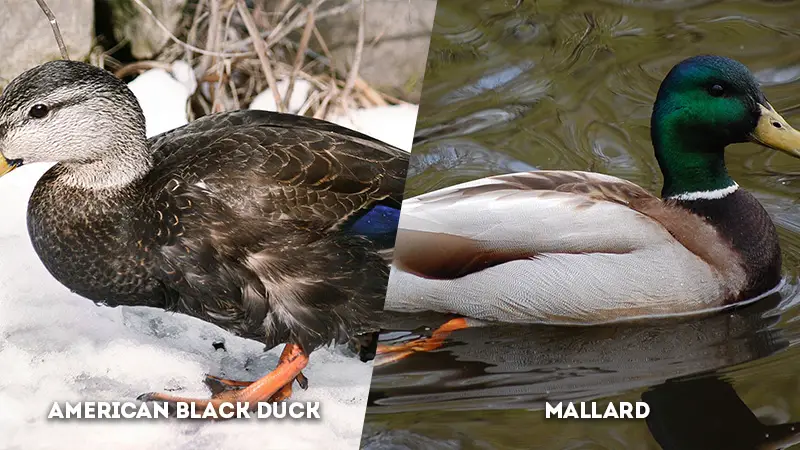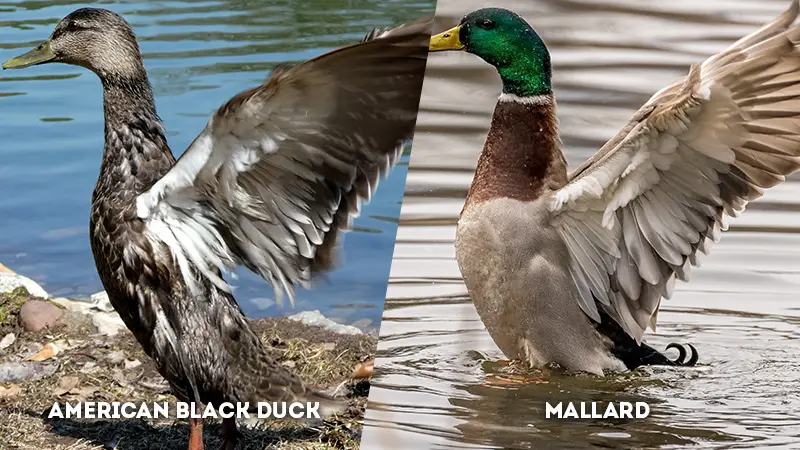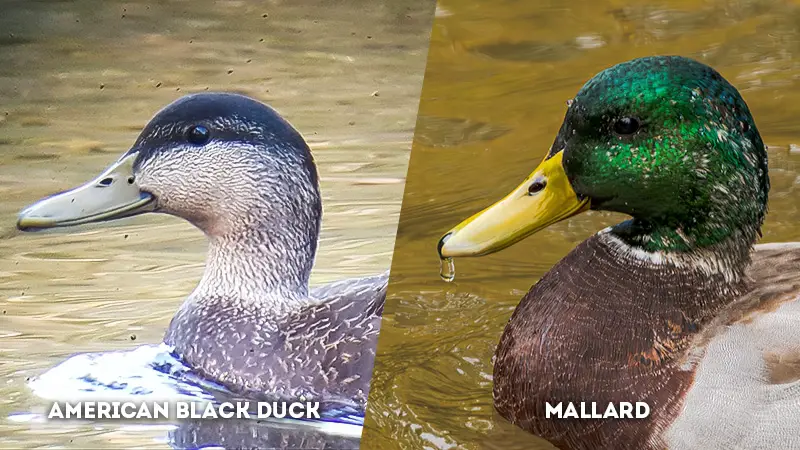In the diverse realm of avian life, the American Black Duck and the Mallard stand as two distinct and captivating duck species, each adorned with unique traits that differentiate them from one another.
From subtle variations in plumage to intricate behaviors, these ducks offer a fascinating glimpse into the intricacies of adaptation and survival.
This exploration of their differences sheds light on how they navigate their habitats, interact with their environments, and respond to the presence of both their fellow species and humans.
Join us as we embark on a journey to uncover the diverse facets that set the American Black Duck and the Mallard apart.

Key Differences Between American Black Duck and Mallard
Here’s a textual representation of the table outlining the key differences between the American Black Duck and the Mallard:
Body Coloration

- American Black Duck: The American Black Duck boasts a dark brown body with a pale gray-brown head. This subdued coloration provides a level of camouflage in the wetland habitats it frequents, allowing it to blend in with the surrounding vegetation and waterscapes.
- Mallard: In contrast, Mallard’s body coloration varies significantly between genders. The male, or drake, possesses a vibrant glossy green head that gleams in sunlight.
Its body is adorned with intricate patterns of buff and brown, while the female, or hen, is more mottled in shades of brown and black.
Bill Color
- American Black Duck: The bill of the American Black Duck is distinct with its yellow-green hue. This color not only aids in identification but also adds a touch of vibrancy to its otherwise subtle appearance.
- Mallard: The Mallard’s bill, in both sexes, is characterized by a yellowish-orange color. This coloration serves as a visual cue for species recognition and is a notable feature of Mallard identification.
Sexual Dimorphism
- American Black Duck: The American Black Duck exhibits less pronounced sexual dimorphism compared to the Mallard. Males and females of this species possess more similar coloring, making it somewhat challenging to differentiate between genders based solely on plumage.
- Mallard: Sexual dimorphism is a hallmark of the Mallard. Males display strikingly distinct plumage with the iconic glossy green head and a white collar.
In contrast, females exhibit a more cryptic mottled appearance that aids in camouflage during nesting.
Underwing Color

- American Black Duck: When in flight, the American Black Duck reveals its bright white underwings. This contrasting feature provides a distinct visual cue, particularly against its darker body, aiding in identification during flight.
- Mallard: The Mallard’s underwings also possess a unique feature. A blue speculum bordered with white catches the eye during flight. This vibrant flash of color helps differentiate Mallards from other ducks in mid-air.
Flight Speculum Color
- American Black Duck: In flight, the American Black Duck’s secondaries, known as the speculum, exhibit an iridescent purple hue. Unlike the Mallard, these purple speculums lack the white borders that often accompany such features.
- Mallard: The Mallard’s flight is characterized by its iridescent blue speculum, which is bordered with distinct white lines. This striking combination of colors serves as a key identifying trait for this species during flight.
Habitat Preference
- American Black Duck: The American Black Duck is often found in freshwater habitats such as ponds, marshes, and estuaries.
These ducks show a preference for more secluded areas, seeking refuge in quiet waters where human disturbance is minimal. Their habitat selection aligns with their shyer behavior. - Mallard: The Mallard’s adaptability extends to its habitat choices. It can thrive in a wide range of environments, from urban ponds to larger lakes and rivers. Mallards are known for their ability to coexist with human populations, often foraging near populated areas.
Behavior Around Humans
- American Black Duck: Due to its shyness and preference for seclusion, the American Black Duck tends to be more cautious and reserved when encountering humans. This behavior reflects its inclination to avoid disturbances and find safety in less populated areas.
- Mallard: The Mallard’s behavior is quite the opposite. Familiarity with human presence has made Mallards more approachable. They are often seen near people, taking advantage of urban water bodies and even feeding from handouts.
Dabbling Behavior
- American Black Duck: Both the American Black Duck and the Mallard exhibit dabbling behavior, where they feed on the water’s surface and tip their heads to reach underwater vegetation.
This feeding technique is a common characteristic among many duck species, enabling them to access their primary food sources. - Mallard: Similar to the American Black Duck, Mallards engage in dabbling behavior. They feed on aquatic plants, insects, and small invertebrates present in their wetland habitats.
Range
- American Black Duck: The American Black Duck primarily inhabits North America, particularly regions of Canada and the United States. Its range extends from the eastern parts of North America to the Atlantic coast.
- Mallard: The Mallard boasts a broader global distribution. Its habitat spans North America, Europe, Asia, and parts of Africa, making it one of the most widely distributed and recognizable duck species worldwide.
Conservation Status
- American Black Duck: The American Black Duck has faced conservation concerns. Habitat loss, hybridization with Mallards, and hunting pressures have led to declining populations in some areas. Conservation efforts are underway to protect and manage their habitats and mitigate hybridization risks.
- Mallard: The Mallard, as a species, does not face significant conservation threats. Its adaptable nature and wide distribution have contributed to its stable status.
While certain local populations might be affected by habitat degradation, the Mallard’s overall conservation status is not a major concern.
Head Color (Males)

- American Black Duck: In contrast to the vivid head coloration of the Mallard’s drake, the male American Black Duck exhibits a pale gray-brown head. This subdued coloring contributes to the duck’s overall understated appearance.
- Mallard: The Mallard’s male, or drake, stands out with its glossy green head, a striking feature that distinguishes it from other duck species. This bold coloration is often associated with the male’s courtship display.
Head Color (Females)
- American Black Duck: Female American Black Ducks display a paler version of their male counterparts’ head coloration. Their duller olive heads contribute to their more cryptic appearance, aiding in blending with their surroundings.
- Mallard: Female Mallards showcase a mottled head with shades of brown and black. This camouflaging plumage helps them hide during nesting periods, allowing them to protect their eggs from potential predators.
Body Color (Females)
- American Black Duck: The body coloration of female American Black Ducks is slightly paler than that of males, maintaining a more uniform appearance between the sexes. This subtlety is in line with their overall unobtrusive presence.
- Mallard: Female Mallards, characterized by streaked and mottled patterns, exhibit an adaptive coloration that aids in both nesting concealment and foraging. Their brown and black markings blend well with their habitat.
Bill Color (Females)
- American Black Duck: The bill color of female American Black Ducks mirrors their males’, displaying a duller olive hue. This feature complements their overall color palette, contributing to their cryptic appearance.
- Mallard: Female Mallards, like their male counterparts, have bill coloration that is more vibrant. Their yellowish-orange bills provide a distinctive visual trait and contribute to species identification.
Shyness
- American Black Duck: The American Black Duck’s shyness is a behavioral trait deeply tied to its habitat preference. These ducks tend to be more reserved in the presence of humans and seek secluded areas to minimize disturbances.
- Mallard: The Mallard’s tolerance for human presence is significantly higher. Their adaptability to urban environments and familiarity with humans make them more approachable and less prone to shyness.
Feeding Habits
- American Black Duck: The American Black Duck’s feeding habits are similar to those of the Mallard. Both species engage in dabbling behavior, foraging on the water’s surface for aquatic plants, small invertebrates, and insects. This feeding technique is well-suited to their wetland habitats.
- Mallard: The Mallard’s feeding habits are characterized by dabbling as well. Their diet includes aquatic vegetation, insects, and small aquatic organisms, making them integral components of their ecosystem’s food chain.
Nesting Preferences
- American Black Duck: American Black Ducks prefer well-concealed nesting sites with dense vegetation to provide cover and protection for their eggs and young. Their choice of secluded areas aligns with their shyer behavior and habitat preferences.
- Mallard: Mallards exhibit more varied nesting preferences. They are known to nest near water bodies, often in open areas. Their nests are well-camouflaged and located in a diverse range of habitats, from grassy banks to reedy marshes.
Voice
- American Black Duck: The vocalizations of the American Black Duck include a combination of quacks and whistles. Their calls are a means of communication, particularly during courtship and interactions with other ducks.
- Mallard: Mallards are known for their distinctive quacking sounds. Their vocalizations serve various purposes, including territorial defense, courtship displays, and social interactions among members of their flock.
Size
- American Black Duck: Both American Black Ducks and Mallards share a similar size, with only slight variations. Their average measurements include a body length of around 20-24 inches (50-61 cm) and a wingspan of about 32-39 inches (81-99 cm).
- Mallard: Mallards also fall within the same size range, with adult males and females exhibiting similar dimensions. This consistency in size is a common trait among many duck species.
Population Dynamics
- American Black Duck: The American Black Duck has experienced population concerns due to factors such as habitat loss, hybridization with Mallards, and hunting pressures. Conservation efforts are focused on managing their habitats, reducing hybridization risks, and ensuring their long-term survival.
- Mallard: Mallard populations are generally stable, owing to their adaptability to various environments. While local populations might face challenges due to habitat degradation, the Mallard’s worldwide distribution and versatility contribute to its overall population dynamics.
Courtship Display
- American Black Duck: During courtship, American Black Ducks engage in complex behaviors such as synchronized swimming, vocalizations, and various displays. These displays are aimed at attracting potential mates and establishing social bonds within their populations.
- Mallard: Mallards are known for their intricate courtship displays, which often involve the male lowering his head, puffing up his chest, and making vocalizations. These displays are not only visually captivating but also integral to pair formation.
Hybridization
- American Black Duck: The American Black Duck is at risk of hybridizing with Mallards, as these species can interbreed. This hybridization poses a challenge to the genetic integrity of the American Black Duck, and conservation efforts are focused on preventing excessive interbreeding.
- Mallard: Mallards are prone to hybridizing not only with American Black Ducks but also with other duck species. This adaptability and propensity for hybridization can lead to genetic introgression and potentially affect the purity of certain species.
Migration Patterns
- American Black Duck: Migration patterns among American Black Ducks vary. While some individuals migrate seasonally, others are more sedentary and remain in their habitats year-round. This flexibility in migration behavior is influenced by factors such as food availability and climate conditions.
- Mallard: Mallards exhibit a wide range of migration patterns, with some populations being migratory, others resident, and some even exhibiting partial migration. This variability is a testament to their adaptability to diverse habitats and environments.
Predator Avoidance
- American Black Duck: The American Black Duck’s shyness and preference for secluded habitats contribute to its predator avoidance strategies. Their cryptic plumage and cautious behavior help them evade potential threats by finding cover and minimizing their exposure.
- Mallard: Mallards are well-versed in predator avoidance as well. Their ability to adapt to various environments allows them to exploit a wide range of habitat features, making it easier for them to find cover and escape predators.
Feeding Techniques
- American Black Duck: Both the American Black Duck and the Mallard employ dabbling behavior for feeding. Dabble feeders skim the water’s surface, sifting through aquatic vegetation and insects. This technique allows them to access food efficiently without fully submerging.
- Mallard: The Mallard’s feeding techniques closely mirror those of the American Black Duck. They use their bills to filter food from the water’s surface, a behavior that aligns with their dabbling nature.
Plumage Patterns
- American Black Duck: The American Black Duck exhibits a generally uniform plumage pattern between sexes. Both males and females share similar coloring, with the females being slightly paler. This uniformity reflects the species’ focus on blending into its wetland surroundings.
- Mallard: Plumage patterns in Mallards show strong sexual dimorphism. Males have the iconic glossy green head and vibrant coloring, while females exhibit mottled and streaked patterns for camouflage during nesting.
American Black Duck vs. Mallard: Comparison Table
| Feature | American Black Duck | Mallard |
|---|---|---|
| Body Coloration | Dark brown body with pale gray-brown head | Varied, glossy green head (males), mottled (females) |
| Bill Color | Yellow-green | Yellowish-orange |
| Sexual Dimorphism | Less pronounced, similar coloring in males and females | Strong, distinct plumage differences |
| Underwing Color | Bright white | Typically blue with white borders (speculum) |
| Flight Speculum Color | Iridescent purple without white borders | Iridescent blue with white borders |
| Habitat Preference | Freshwater habitats like ponds, marshes, estuaries | Versatile, found in various water bodies |
| Behavior Around Humans | Shy, less accustomed to human presence | More approachable, often seen near people |
| Dabbling Behavior | Yes, feeds on the water’s surface and tips head underwater | Yes, feeds on the water’s surface and tips its head underwater |
| Range | Primarily North America | Worldwide distribution |
| Conservation Status | Population concerns due to habitat loss and hybridization | Widespread, no significant conservation status |
| Head Color (Males) | Pale gray-brown | Glossy green |
| Head Color (Females) | Paler, duller olive | Streaked and mottled in shades of brown and black |
| Body Color (Females) | Slightly paler than males | Mottled, streaked |
| Bill Color (Females) | Duller olive | Yellowish-orange |
| Shyness | Tends to be more cautious and reserved | Can be more accustomed to human presence |
| Feeding Habits | Similarly, feeds on water vegetation and insects | Sometimes hybridizes with Mallard |
| Nesting Preferences | Well-concealed sites, dense vegetation | Varied, nests near water, often in open areas |
| Voice | Quacks and whistles | Quacks and whistles |
| Size | Similar in size, with slight variations | Similar in size, with slight variations |
| Population Dynamics | Population concerns, conservation efforts in place | Generally stable, adaptable species |
| Courtship Display | Complex behaviors involving swimming and vocalizations | Intricate courtship displays |
| Hybridization | More reserved behavior seeks cover | Can hybridize with other ducks |
| Migration Patterns | Some individuals migrate, while others are resident | Wide range of migration patterns |
| Predator Avoidance | Dabble-feed on the water surface | Can adapt to various environments |
| Feeding Techniques | Dabble-feed on water surface | Dabble-feed, also dive briefly for food |
| Plumage Patterns | Generally uniform between sexes | Strongly differentiated between sexes |
Frequently Asked Questions
American Black Ducks engage in courtship displays involving synchronized swimming and vocalizations. Mallards, on the other hand, showcase intricate behaviors like the drake lowering his head, puffing up his chest, and vocalizing to attract mates.
While American Black Ducks are at risk of hybridizing with Mallards, they primarily interbreed with closely related species. Hybridization poses a genetic integrity concern, leading to conservation efforts to mitigate excessive interbreeding.
The migration behavior of American Black Ducks is influenced by factors like food availability and climate conditions. Some individuals migrate seasonally, while others remain sedentary or exhibit partial migration based on local conditions.
American Black Ducks rely on their shyness and preference for secluded habitats to avoid predators. In contrast, Mallards’ adaptability to various environments allows them to exploit a wide range of habitat features for cover and protection.
While both species exhibit quacking vocalizations, American Black Ducks also incorporate whistles into their communication repertoire. Mallards, however, are known for their distinct quacking sounds, which serve various purposes such as territorial defense and social interactions.
To Recap
In the world of waterfowl, the American Black Duck and the Mallard exemplify the beauty of adaptation and diversity. Through dissecting their varied characteristics – from courtship displays to migration patterns – we’ve unveiled the intricate tapestry of their lives.
These ducks teach us that nature’s canvas is painted with an array of strategies for survival, from the shyness of one to the adaptability of the other.
By embracing the unique attributes of these species, we gain a deeper appreciation for the complexity of life and the fascinating ways in which creatures navigate the ever-changing landscapes that define their existence.